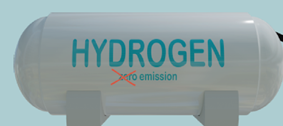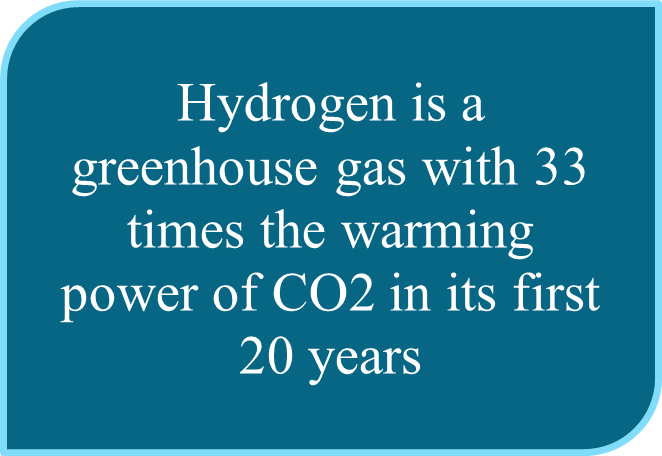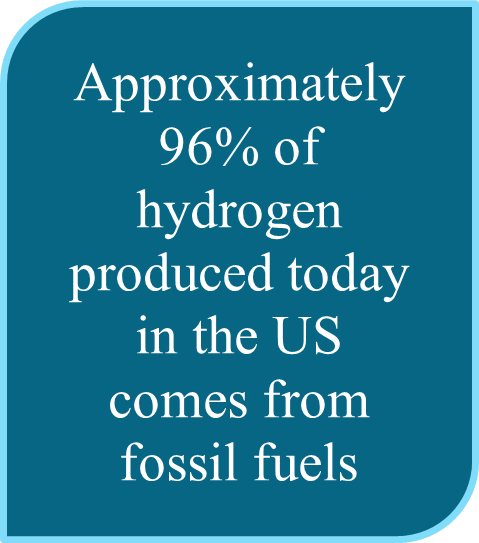Hydrogen: A False Solution to the Climate Crisis
Hydrogen production can be understood using a color scheme. Pink hydrogen is produced using nuclear power as its feedstock, black or brown using coal. The most common hydrogen color designations, however, are gray, green, and blue. Ninety-six percent of the hydrogen being produced today, known as gray hydrogen, is produced using fracked gas, a process whose greenhouse gas emissions make it an unacceptable solution for reducing our carbon footprint. At the other end of the spectrum is green hydrogen, which is produced using renewable energy. Although, eventually, green hydrogen could be a means of reducing the emissions of hard-to-decarbonize industries (like cement and steel production, heavy transport, and aviation), at present it is too expensive to produce at scale [DW 2023]. The misleadingly generic term “clean hydrogen” being used today to describe the federally-supported impetus behind a “new economy” is blue hydrogen, a concept promoted by the oil and gas industry and touted in their reports as an environmentally friendly alternative. Blue, like gray hydrogen, is produced using fracked gas, but with carbon capture and storage technology (CCS) added on to hypothetically remove CO2 emissions from the atmosphere and then either store that carbon underground or use it for enhanced oil recovery (EOR). By the year 2050, according to an International Energy Agency report, “fossil fuels will remain the primary source of hydrogen” for the United States, Europe, and Japan [US DOE 2020].

The Department of Energy (DOE) named seven U.S. locations as possible sites for Hydrogen Hubs in October, 2023, two of which include Pennsylvania: the MACH2 or Mid-Atlantic Clean Hydrogen Hub (a coalition that includes Delaware, New Jersey, and southeast Pennsylvania) and the ARCH2 or Appalachian Regional Clean Hydrogen Hub (a consortium that includes West Virginia, Ohio, Kentucky, and Pennsylvania) [MACH2 2023; ARCH2 2023]. Both projects are currently in the initial planning phase. Proponents of these hydrogen hubs are interested in using the Commonwealth’s abundant fossil fuel resources to make hydrogen from fracked gas with CCS (blue hydrogen) and then use pipelines to transport both the hydrogen and the captured carbon dioxide to markets or storage sites. In some cases, transporting hydrogen in already existing fracked gas pipelines as something called “HyBlend” has also been proposed [EERE 2023].
Our concerns:
Proponents of this technology have not adequately evaluated the risks associated with transporting hydrogen in pipelines, the increased carbon footprint associated with making hydrogen from fracked gas with CCS, the costs and uncertainties associated with using CCS in these projects, the increased need for regulation of this new industry, and the cost of tax subsidies for this industry to PA taxpayers. The push for this technology in PA is focused on continuing the use of fracked gas in the commonwealth. According to a recent article from StateImpact Pennsylvania, “The gas industry and its backers are promoting the use of gas to make hydrogen. After the hydrogen hubs announcement, the Marcellus Shale Coalition said on its website, ‘The developments are positive for further innovative uses of our abundant natural gas resources’” [StateImpact Pennsylvania 2023].
Transportation issues and hydrogen embrittlement: Hydrogen brings with it a range of transportation issues. It is a highly volatile, flammable gas and a very small molecule that can escape containment in pipelines and vessels, meaning it can be expected to leak during transport, particularly from pipelines that were originally constructed for a larger-volume gas like methane. It also causes hydrogen embrittlement, or hydrogen-assisted cracking, a process in which hydrogen permeates solid metals, particularly steels, and causes gaps, leaks, and breakdown of the ductile properties of the metal. Once it is absorbed into the metal, hydrogen increases the chances for initiation and propagation of cracks and fissures through which the hydrogen can escape. It will be risky, therefore, to transport meaningful amounts of hydrogen through our existing steel pipelines [TWI Global 2023]. Also, plans to pipe hydrogen into homes and to run appliances will need to take this problem into consideration, adding expense. Additional problems can arise due to the fact that hydrogen flames are invisible to the human eye, meaning that those leaks will not be easily detected — unless expensive detection devices are put in place — raising the likelihood of explosion. Thus, to ensure safety, sensors will need to be employed all along the hydrogen distribution route, and our existing transportation networks will need to be overhauled [The Street 2022].

The term “HyBlend” has been coined by the U.S. Department of Energy as part of its recent initiative to determine the feasibility of introducing hydrogen into already-existing fracked gas pipelines [NREL 2023]. A recently published report on HyBlend by the Pipeline Safety Trust, a nonprofit public watchdog promoting pipeline safety, raises serious concerns about the safety risks of transporting hydrogen by pipeline, whether as pure hydrogen or as a blend, and cautions that transportation of hydrogen is “significantly more dangerous” than transportation of methane gas. Hydrogen’s greater flammability makes it more likely than methane to explode; hydrogen causes embrittlement in steel and polyethylene pipelines, leading to cracking, subsequent leakage and even systemic failure. And hydrogen’s greater propensity to leak means that its transportation will introduce into the atmosphere an additional greenhouse gas, with 33 times the warming power of CO2 in its first 20 years. The report concludes: “Hydrogen blending in most U.S. existing gas pipeline systems may not prove viable” [Pipeline Safety Trust 2023].

High carbon emissions: Because fossil fuels are used both to produce blue hydrogen and operate its carbon capture technology, the carbon emissions produced are unacceptably high. According to Robert Howarth, Cornell professor and co-author of a recent scholarly paper titled “How Green is Blue Hydrogen?”, “If we compare it to natural gas, blue hydrogen actually has a worse greenhouse gas footprint than if you simply were to burn natural gas for fuel. So it’s just not a good idea in terms of its climate impact” [Better Path Presents 2022; Howarth and Jacobson, 2021]. Additionally, studies show that burning hydrogen negatively impacts both human health and the environment. When burned in air, hydrogen emits nitrogen oxide (NOx), which contributes to smog and acid rain and reduces lung function as well as causing long-term lung damage [Reuters News 2023]. In agreement with these conclusions, a recent report from the Institute for Energy Economics and Financial Analysis (IEEFA) criticized the assumptions used by DOE to evaluate the greenhouse gas emissions associated with proposed US hydrogen projects as “unrealistic and flawed” and concluded that blue hydrogen from natural gas has a carbon intensity as much as five times higher than the DOEs Clean Hydrogen Production Standard, meaning blue hydrogen is “dirty and high carbon” [IEEFA 2023].
Carbon capture and storage technology, an essential component in the production of blue hydrogen, has been demonstrated to be extremely expensive, energy-intensive, technically difficult, less economical than renewables, and ineffective at reducing CO2 emissions. In addition, the safety of CO2 pipelines has not been established, and CO2 sequestration in geological formations is untested, poses significant risks, and will require monitoring for generations to come [CHPNY 2023].
No established regulatory framework: The DOE is rushing to fund hydrogen projects without taking the time to establish a regulatory framework. A recent IEEFA report criticized the DOE for underestimating the amount of methane that will be emitted into the atmosphere during transportation from well to facility, for underestimating hydrogen’s global warming impact when leaked into the atmosphere, and for overestimating the amount of carbon dioxide that hydrogen projects with carbon capture will be able to remove from the air. The report also faults DOE’s analysis for excluding downstream emissions from produced hydrogen as well as from the generation of electricity needed to compress, store, and deliver that hydrogen to its users. The report concludes that blue hydrogen, especially, is neither clean nor low-carbon nor a solution and that IEEFA is “extremely concerned” that the hype around hydrogen will encourage us to support projects that worsen climate change and lock in our dependence on fossil fuels for decades [IEEFA 2023]. Environmentalists are pushing back against those who claim that investing in hydrogen will bring jobs to the state by raising serious questions about hydrogen production and its concomitant carbon capture and storage, as well as about the necessary regulatory framework that a hydrogen build-out will require [Appalachia Hydrogen Facts 2023; ORVI 2023].

Burdensome tax subsidies: With regard to tax subsidies, Sean O’Leary, senior researcher with the Ohio River Valley Institute, estimates in a recent report that building one hydrogen hub (with its associated facilities) in the Pittsburgh area will cost taxpayers in that area between $1000 to $2500 per household, per year. The costs of constructing and operating CCS facilities is so prohibitive for owners and shareholders that they’re unwilling to consider these projects without financial incentives. And that means that the homeowner will be facing higher utility and tax bills. He concludes: “That leaves us ratepayers and taxpayers on the hook. And make no mistake. We’re talking real money. . . . We’re talking about actual physical costs –more equipment and more raw materials – which must be paid, whether it is done through your utility bill or your tax bill. And to say, “The federal government will pay” is just another way of saying, “Taxpayers will pay”’ [ORVI 2022].
The bottom line: Although there is a potential market for green hydrogen to power hard-to-electrify industries, widespread use of blue hydrogen technologies to make hydrogen for transportation, household use, or lighter industrial applications appears to be too expensive (due to the need for CCS) and too uncertain (due to its transportation and storage problems). It also poses health and environmental hazards, including its risk of explosion as well as its global warming impact. Subsidizing blue hydrogen will lock us into dependence on fossil fuels for decades and will ultimately serve to distract us from expanding development and implementation of proven renewable energy technologies.
- Appalachian Regional Clean Hydrogen Hub (ARCH2). Available from: https://www.arch2hub.com/. Accessed 30 November 2023.
- Appalachia Hydrogen Facts. 2023. Available from: https://appalachiahydrogenfacts.org/#:~:text=If%20built%2C%20a%20hydrogen%20hub%20would%20create%20a,will%20continue%20to%20see%20job%20and%20population%20loss. Accessed 30 November 2023.
- Better Path Presents. Robert Howarth. How Green is Blue Hydrogen? 21 September 2022. Available from: https://vimeo.com/752623478?utm_campaign=5250933&utm_source=affiliate&utm_channel=affiliate&cjevent=1a5ccf8b45c311ee803f03180a82b838&clickid=1a5ccf8b45c311ee803f03180a82b838. Accessed 11 September 2023.
- Concerned Health Professionals of New York (CHPNY) and Physicians for Social Responsibility (PSR). Compendium of Scientific, Medical, and Media Findings Demonstrating Risks and Harms of Fracking and Associated Gas and Oil Infrastructure. Ninth edition. 2023. Available from: https://concernedhealthny.org/wp-content/uploads/2023/10/CHPNY-Fracking-Science-Compendium-9.pdf. Accessed 25 October 2023.
- DW. Green Hydrogen: How can it help stop climate change? Ajit Naranjan. 2023. Available from: https://www.dw.com/en/green-hydrogen-climate-change-explainer/a-64619574. Accessed 30 November 2023.
- EERE. Office of Energy Efficiency and Renewable Energy. HyBlend: Opportunities for Hydrogen Blending in Natural Gas Pipelines. 2023. Available from: https://www.energy.gov/eere/fuelcells/hyblend-opportunities-hydrogen-blending-natural-gas-pipelines. Accessed 30 November 2023.
- Howarth R and Jacobson MZ. How Green is Blue Hydrogen? Energy Science and Engineering. 2021;9 (10): 1676-1687. Available from: https://onlinelibrary.wiley.com/doi/full/10.1002/ese3.956. Accessed 11 September 2023.
- Institute for Energy Economics and Financial Analysis (IEEFA). Blue hydrogen: Not clean, not low carbon, not a solution. 2023. Available from: https://ieefa.org/resources/blue-hydrogen-not-clean-not-low-carbon-not-solution/ Accessed 30 November 2023.
- Mid-Atlantic Clean Hydrogen Hub (MACH2) Available from: https://mach-2.com/. Accessed 30 November 2023.
- National Renewable Energy Laboratory (NREL). Hydrogen Blending as a Pathway Toward U.S. Decarbonization. 2023. Available from: https://www.nrel.gov/news/program/2023/hydrogen-blending-as-a-pathway-toward-u.s.-decarbonization.html. Accessed 17 September 2023.
- Ohio River Valley Institute (ORVI). 2023. Statement on Federal Funding for the Appalachian Regional Clean Hydrogen Hub. Available from: https://ohiorivervalleyinstitute.org/statement-on-federal-funding-for-the-appalachian-regional-clean-hydrogen-hub/. Accessed 30 November 2023.
- Ohio River Valley Institute (ORVI). 2022. What A Pennsylvania Hydrogen and Carbon Capture Hub Would Cost. Sean O’Leary. Available from: https://ohiorivervalleyinstitute.org/what-a-pennsylvania-hydrogen-and-carbon-capture-hub-would-cost/. Accessed 30 November 2023.
- Pipeline Safety Trust. Hydrogen Pipelines: Unique Risks Prove Dangerous for Pipeline Transportation. 2023. Available from: https://pstrust.org/hydrogen-pipelines-unique-risks-prove-dangerous-for-pipeline-transportation/. Accessed 17 September 2023.
- Reuters News. Paul Day. Hydrogen as a backup for renewables remains a distant proposition. 2023. Available from: https://www.reuters.com/business/energy/hydrogen-backup-renewables-remains-distant-proposition-2023-02-01/. Accessed 25 October 2023.
- StateImpact Pennsylvania. Pa. lawmakers look for hydrogen models after hub announcement. Rachel McDevitt, November, 2023. Available from: https://stateimpact.npr.org/pennsylvania/2023/11/22/pa-lawmakers-look-for-hydrogen-models-after-hub-announcement/ Accessed 2 December 2023.
- The Street. Maxx Chatsko. 2022. The Hydrogen Economy Faces Big Challenges Despite the hype, hydrogen is a poor fuel facing major obstacles. It may only play a marginal role in the energy transition. Available from: https://www.thestreet.com/investing/the-hydrogen-economy-faces-big-challenges. Accessed 11 September 2023.
- TWI Global. What is hydrogen embrittlement? Causes, effects, and prevention. 2023. Available from: https://www.twi-global.com/technical-knowledge/faqs/what-is-hydrogen-embrittlement. Accessed 30 November 2023.
- United States Department of Energy (US DOE). Hydrogen Strategy. Enabling a low carbon economy. Office of Fossil Energy. 2020. Available from: https://www.energy.gov/sites/prod/files/2020/07/f76/USDOE_FE_Hydrogen_Strategy_July2020.pdf. Accessed 30 November 2023.
No False Solutions is a coalition of advocacy groups and concerned residents of Pennsylvania and other states in our region affected by the oil and gas industry. The group aims to educate and inform legislators and decision makers about emerging technologies that claim to be solutions to the climate crisis but in fact exacerbate the climate crisis, damage the environment, and/or harm public health and do not offer more effective or economically viable solutions than those offered by renewable energy and renewable energy storage technologies.
Leave a comment